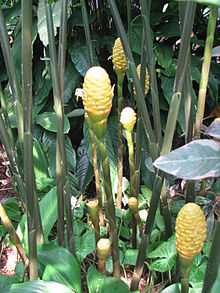Zingiber zerumbet
| Awapuhi | |
|---|---|
| | |
| Scientific classification | |
| Kingdom: | Plantae |
| (unranked): | Angiosperms |
| (unranked): | Monocots |
| (unranked): | Commelinids |
| Order: | Zingiberales |
| Family: | Zingiberaceae |
| Genus: | Zingiber |
| Species: | Z. zerumbet |
| Binomial name | |
| Zingiber zerumbet (L.) Roscoe ex Sm. | |
Zingiber zerumbet (awapuhi), also known as shampoo ginger (Malay = lempoyang) or pinecone ginger,[1] is a vigorous species of the ginger family with leafy stems growing to about 1.2 m (3.9 ft) tall. It is found in many tropical countries. The rhizomes of Z. zerumbet have been used as food flavoring and appetizers in various cuisines while the rhizome extracts have been used in herbal medicine.
Description
Z. zerumbet is a perennial. From autumn until spring it goes dormant above ground as the leafy stems shrivel and die away, leaving the pale brown, creeping stems (rhizomes) at ground level. In the spring, the plant springs up anew. The 10-12 blade-shaped leaves 15–20 cm long grow in an alternate arrangement on thin, upright stem to 1.2 m (3.9 ft) tall. Among the leafy stems, the conical or club-shaped flower heads burst forth on separate and shorter stalks. These appear in the summer, after the leafy stems have been growing for a while. The flower heads are initially green and are 3 to 10 cm (1.2 to 3.9 in) long with overlapping scales, enclosing small yellowish-white flowers that poke out a few at a time. As the flower heads mature, they gradually fill with an aromatic, slimy liquid and turn a brighter red color. The flower stalks usually remain hidden beneath the leaf stalks.
Distribution
This plant, originating in India, was distributed eastward through Polynesia and introduced to the Hawaiian Islands in the canoes of early Polynesian settlers.
Uses
The juice can be used to quench thirst when out walking in the forest and can be combined with mountain apples as a meal.
Medicinal uses

In Hawaii, the spicy-smelling fresh rhizomes were pounded and used as medicine for indigestion and other ailments. The rhizomes can be stored in a cool, dark place to keep for use when needed. In traditional use, the rhizome was ground in a stone mortar with a stone pestle, was mixed with a ripe noni fruit and then used to treat severe sprains. The pulp was placed in a cloth and loosely bound around the injured area.
For a toothache or a cavity, the cooked and softened 'awapuhi rhizome was pressed into the hollow and left for as long as was needed. To ease a stomach ache, the ground and strained rhizome material is mixed with water and drunk. Similarly, 'awapuhi pake or ginger root (Zingiber officinale) is widely cultivated and eaten, or made into a tea for indigestion, as well as increased circulation of the blood and an increased sense of well-being. Rhizome extracts have been used in Malay traditional medicine for various types of ailments such as inflammatory- and pain-mediated diseases, worm infestation, and diarrhea.[2]
An extract, zerumbone, from Z. zerumbet, has been found to induce apoptosis, or programmed cell death, in human liver cancer cells, in an in vitro study.[3]
Mythology
'Awapuhi is said to be one of the Kinolau, multiple forms, of the Hawaiian deity Kane.
Indigenous practices
The leaves and leaf stalks, which are also fragrant, were used in baking in the imu, underground oven, to enhance the flavor of pork and fish as they cooked. Traditionally, the aromatic underground rhizomes were sliced, dried, and pounded to a powder, then added to the folds of stored kapa (tapa) cloth.
Perhaps the most common use of 'awapuhi is as a shampoo and conditioner for the hair. The clear, slimy juice present in the mature flower heads is excellent for softening and bringing shininess to the hair. It can be left in the hair or rinsed out. Hawaiian women often pick or cut the flowerheads of this plant in the forest, as they approach a pool or waterfall for a refreshing summer bath, leave the flowers atop a nearby rock, and then squeeze the sweet juices into their hair and over their bodies when the swim is completed. The sudsy juice is excellent for massage, also.
References
- ↑ "Floridata – Zingiber zerumbet", Retrieved 2014-03-18
- ↑ Yob NJ, Jofrry SM, Affandi MM, Teh LK, Salleh MZ, Zakaria ZA (2011). "Zingiber zerumbet (L.) Smith: A Review of Its Ethnomedicinal, Chemical, and Pharmacological Uses". Evid Based Complement Alternat Med 2011: 543216. doi:10.1155/2011/543216. PMC 3092606. PMID 21584247.
- ↑ Sharifah Sakinah, SA; Tri Handayani, S; Azimahtol Hawariah, LP (2007). "Zerumbone induced apoptosis in liver cancer cells via modulation of Bax/Bcl-2 ratio". Cancer Cell International 7: 4. doi:10.1186/1475-2867-7-4. PMC 1852295. PMID 17407577.
External links
| Wikimedia Commons has media related to Zingiber zerumbet. |
| Wikispecies has information related to: Zingiber zerumbet |